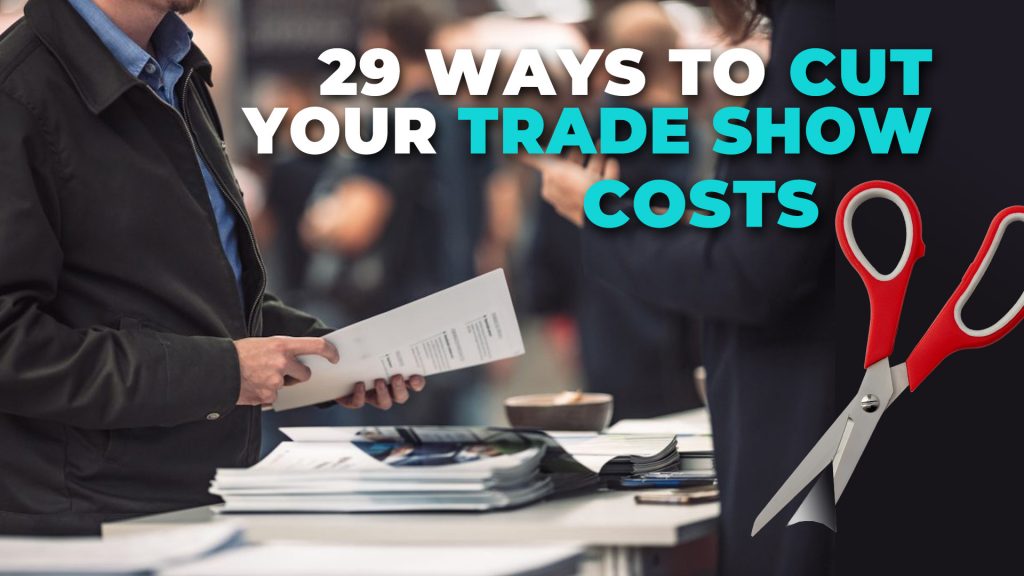
Most companies love the concentrated sales and marketing potential of trade shows. A successful show can boost sales, increase visibility, and transform a company’s brand in the marketplace. All that comes with a cost however. Trade shows can be more expensive than other forms of marketing. And trade show costs can quickly escalate if not carefully managed.
Sadly, many exhibitors are guilty of two self-inflicted mistakes when it comes to trade shows. They don’t have a comprehensive sales and marketing strategy, and they don’t manage their trade show costs before, during, and after the event.
Let’s change that. All 29 Ways to Cut Trade Show Costs may not apply to every exhibitor, but there’s a good chance that 20-25 do, even for more experienced trade show warriors. Some are small changes. Others are more significant. But all represent opportunities to improve your return on investment or return on objectives.
Admittedly, some recommendations may seem counterintuitive, like paying for supervision or staging your exhibit before a show. However, those expenses will save time and money at the show site and avoid costly surprises and unnecessary stress. We’ll start by identifying the most common trade show costs.
Understanding Trade Show Costs: Where Does the Money Go?
Let’s divide trade show costs into categories. Keep in mind that some expenses might not apply to your situation. And the budget doesn’t consider the salaries or time of employees who participate in trade show planning or participation at a show. For a comprehensive review—including how to create and manage expenses plus a sample spreadsheet—read our full trade show budget guide.
Exhibit
- Design Fees – Structure and Graphics
- Exhibit – Structure, and Graphics
- Shipping (if applicable)
- Ongoing Storage
- Show Services
Show Site
- Shipping (to and from the show)
- Booth Space
- Drayage or Material Handling
- Electrical
- I&D Labor
- Furniture Rental
- Flooring
- Hanging Sign Rigging (if applicable)
- Internet
Travel, Lodging, and Entertainment
- Travel/Transportation
- Hotel
- Meals
- Client Meals and Entertainment
Other
- Literature
- Promotional Products
- Housekeeping/Cleaning
- Lead Retrieval Software
- Games/Talent/Prizes
Most of these costs are self-explanatory, but terms like show management/storage, drayage, electrical, and labor can be confusing. For a deeper dive into what they mean, check out our full Trade Show Terminology glossary.
Minimizing Trade Show Booth Costs: Design & Graphics
1. Modular Exhibit Design
Modular design is a great way to save money for companies that exhibit frequently and in multiple configurations, such as islands and inlines. Modular design lets you transition from a larger to a smaller exhibit–– and vice versa–– using the same basic structure.
The term “modular” is often misunderstood, but a modular exhibit can be a portable, hybrid, or custom display. It simply means it’s reconfigurable. If your exhibit marketing goals are flexible, owning a modular design will save you the expense of owning several unique static designs for each size–– 10 ft., 20 ft., or island.
When considering modular design for your next booth, consider incorporating an attached overhead sign to replace a hanging sign. You’ll get the same visibility as a hanging sign, but without the expense of rigging charges. They can be expensive, but incorporating them in your design from the beginning can save you money in the long run.
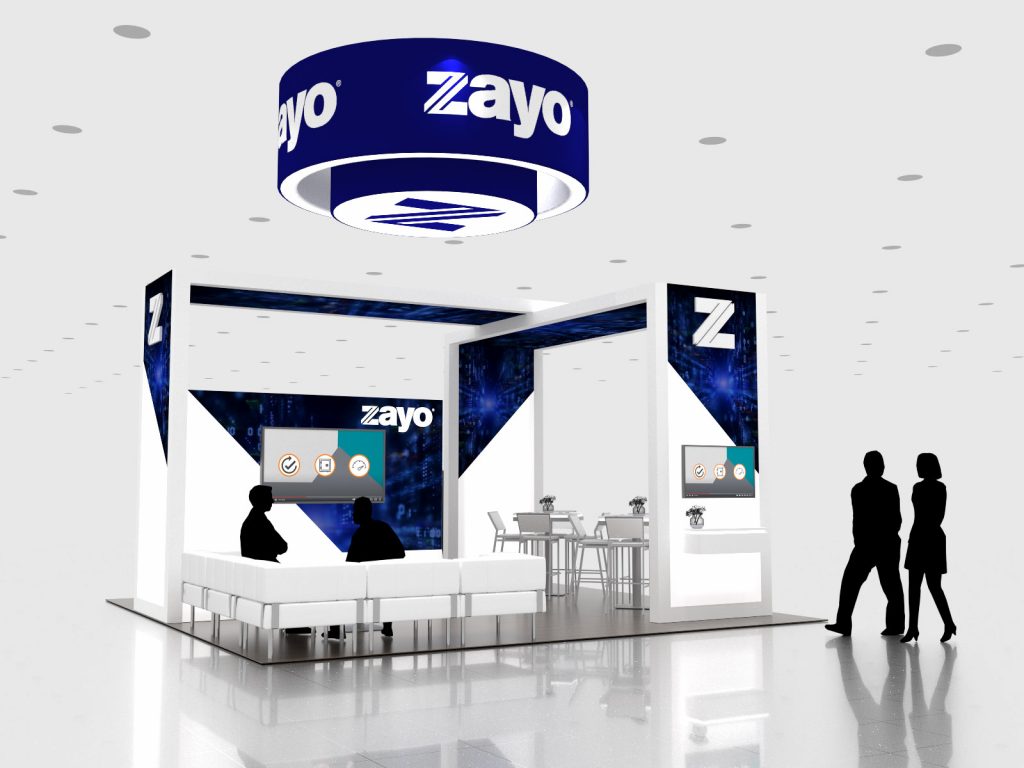
2. Rental Exhibits
Exhibit rentals have come a long way with expanded design options. Renting an exhibit is a great option if you have a limited budget or simply want to test the waters at a show. Your options are nearly as varied as if you were purchasing an exhibit, but without the fixed upfront cost. Walk any major industry show … probably 15-20% of the exhibits are rentals, but it’s unlikely you’ll be able to tell the difference.
The other advantage of a rental is design flexibility from show to show. Rentals make it easy to change your message, the structure, or the size. It allows you to experiment. Plus, there is a lower upfront cost, and you’re not responsible for maintenance or storage. This allows you to focus only on your trade show marketing program. You can also look at components in your booth as rental options, like monitor stands or reception counters. A combination of rentals and ownership can save you money.
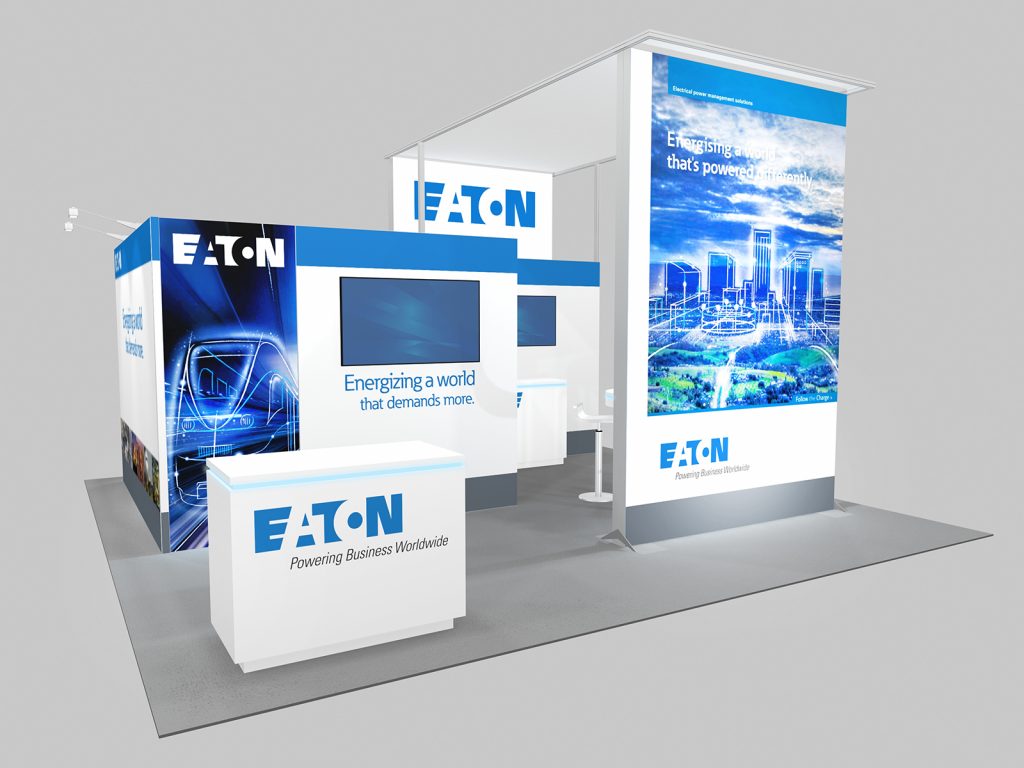
3. Tension Fabric vs. Direct Print Graphics
Fabric graphics dominate the trade show scene. And they should. They are vibrant, lightweight, and durable. Recent fabric print innovations make them nearly identical to direct prints, without the hassle of complicated crating or special packaging. The key to fabric graphics is to insist on HD quality. Printing technology is evolving very fast. What was acceptable three years ago appears muddy by comparison to newer printing techniques. Do your homework, ask for details about their equipment, and get quotes from several sources.
Does that mean that direct print graphics have gone the way of the dinosaur? No. They are appropriate for small graphics, dimensional applications, and where the chance of damage is minimal. However, in the long run, fabric graphics will likely last longer. And they are easier to clean if you get them dirty.
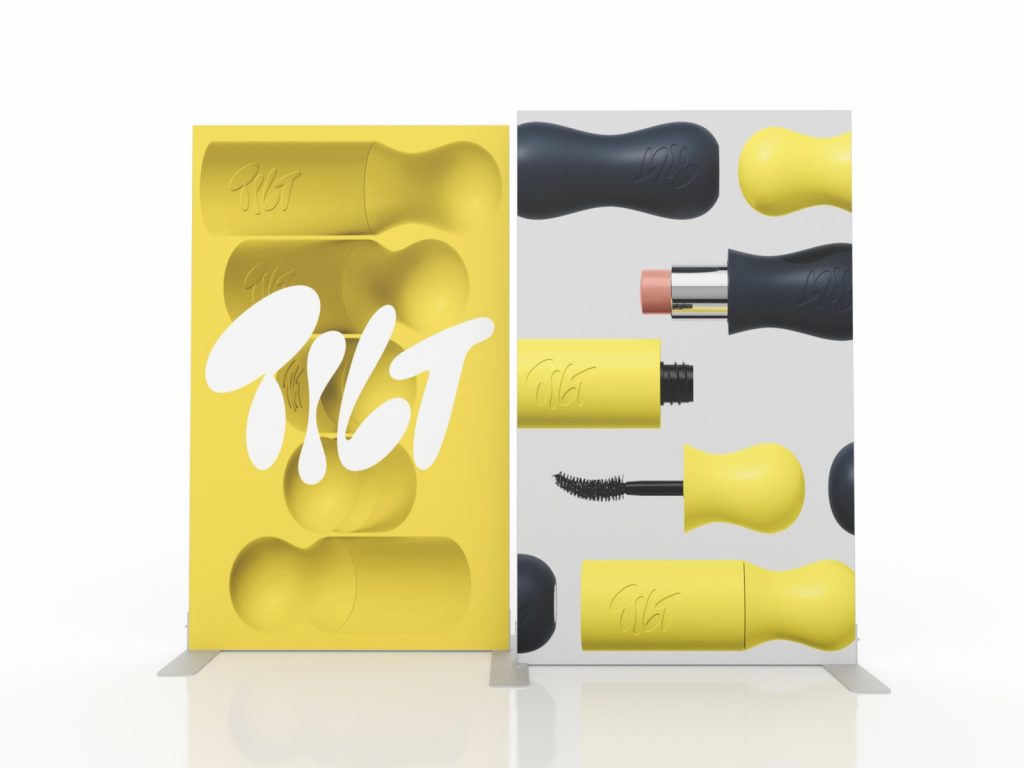
Lower Your Trade Show Setup, Dismantle, & Labor Costs
4. Pre-Wired Electrical & A/V
Everybody makes this mistake. It happens. We’re so focused on the exhibit design that we don’t consider all the electrical components and wiring going into the booth space. If you’re going to have monitors or laptops in your booth, or need to have a particular lighting configuration, all of these things need to be considered in the beginning while the exhibit is being built.
Once the exhibit moves from the shop floor to the show floor, the costs to make changes to your booth not only increase exponentially (sometimes by a factor of 10), but the final solution is also rarely as elegant as one that would have made sense during construction. Plan for where the lead retrieval device will go. Think about all the computers, laptops, and monitors. Make every effort to prewire the lighting. You’ll save time, money, and headaches, and avoid damaging your exhibit at the show.
5. Complete Setup/Assembly Instructions
No one expects you to read the owner’s manual for your new toaster. You get a pass on that. However, the setup instructions for your booth are a different story. You need to review them and determine if they make sense before the show–– both how the booth is assembled and how it’s disassembled and repacked.
If you don’t understand the instructions while on the show floor, you’re going to waste both time and money. If you find mistakes in the instructions, go back to your exhibit house and ask them to make corrections. We’ve all experienced the moment during installation where three to four people are standing around trying to make sense of the next step. Sometimes that’s a minute or two. Other times it’s much longer, and the clock is ticking on your labor bill the whole time.
6. Hire a Supervisor from Your Exhibit House
If your exhibit house offers to send a supervisor to the show for a fee, you may want to consider it. They are familiar with the assembly of the booth, saving you time and labor costs during setup and dismantle. If there is a problem, that person is the direct path to a solution, whether locally or from the exhibit house.
It may not make sense for a smaller inline, but it’s usually a good idea for larger, more complex booths, especially the first time the exhibit is assembled on the show site. Given a choice, would you rather supervise the assembly of your booth or devote your time to all the other responsibilities necessary to ensure your show is a success?
7. Communicate with Your Labor Exhibitor Appointed Contractor (EAC)
You may be familiar with trade show labor – the labor provided by the show contractor to help set up your booth – but you may be unfamiliar with Exhibitor Appointed Contractors, or EACs. These are independent companies that have the right to provide labor services within a convention center.
Working with an EAC offers multiple benefits. While you may not save a lot of money in a one-off situation, you will save money over time by contracting with an EAC. They are invested in keeping your business and making accommodations that you won’t get from the regular labor pool, because they’re goal is to keep you as a client for multiple shows.
An EAC encourages you to communicate with them before the show by sending them your setup instructions, photos, and other details. This allows them to plan, and planning always saves money. If you have a lasting relationship with an EAC, they will understand and remember how your booth is assembled each year, and correct problems quickly and effectively, ultimately speeding up the process and saving you hours of labor. For more information about EACs, contact EACA, the Exhibitor Appointed Contractors Association.
8. Monitor Setup and Dismantle Times
In most cases, there is a four-hour minimum for trade show labor. Pay attention to that minimum. Exhibitors get skittish about overtime (and should). However, there are times when you can complete I&D with just an hour of overtime. That overtime will be less expensive than scheduling labor for four hours the next day.
Minimums also matter when scheduling how many laborers you need in the booth. Three workers working on straight time is less expensive than two workers working straight-time and overtime. While it’s not always an exact science, it should be a planned decision, not one that happens by chance.
9. Dismantle Supervision
It’s the end of the show, and you’re exhausted. The last thing you want to do is dismantle your booth. But having someone stay with the booth to oversee the dismantling can be critical.
That person can supervise the disassembly and monitor that the booth gets packed and labeled correctly. Even if it means one more night at a hotel or a couple more meals, that person is invaluable to ensuring your booth isn’t damaged and is ready for the next trade show.
The number one cause of damage isn’t assembly. It’s careless disassembly and packaging. In the chaos after the show, it’s not unusual for parts and pieces to get lost or stolen. Being there minimizes those surprises.
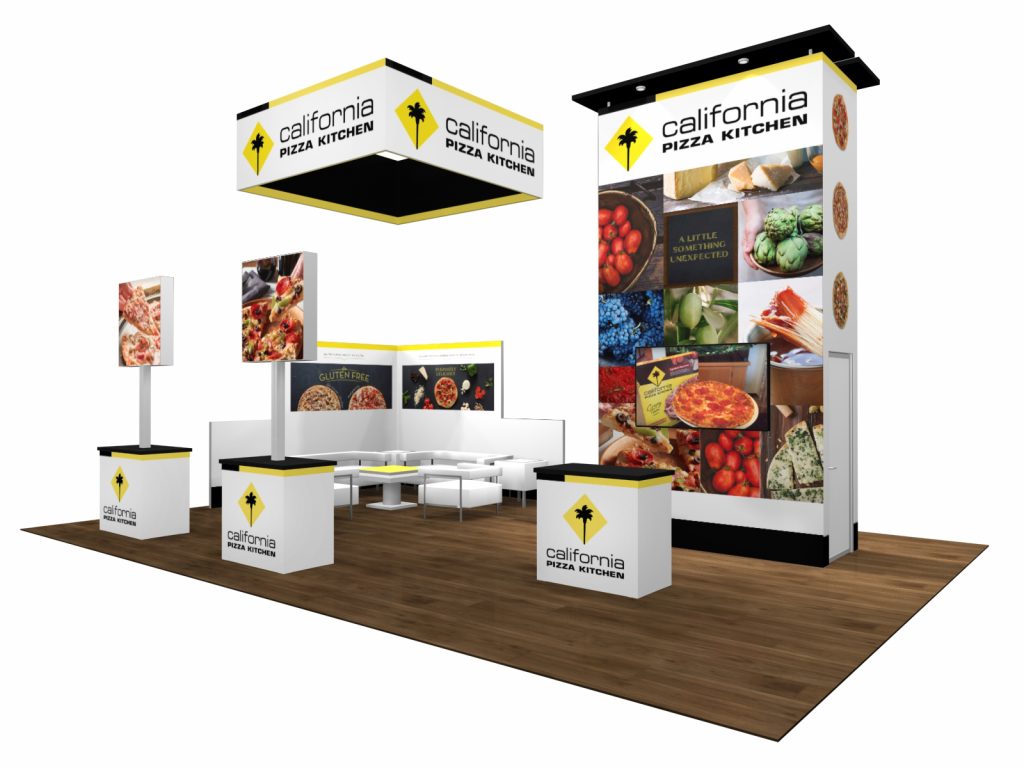
Reduce Trade Show Shipping Costs & Packaging Costs
10. Crate or Case Design
Yes, the actual design of your new exhibit is important, but so is the design of the crates or cases. Make sure you’re using space in the most optimal way possible. If you plan to bring literature and promotional products to the show, consider packing them in the crates or cases rather than sending them in separate shipments. Same with monitors which can be expensive to ship separately and the possibility of damage increases with each shipment.
Having these conversations with your exhibit house can reduce your material handling/drayage bill significantly. Talk about the size of the crate and what goes in it. It’s much cheaper to have monitors, promotional products, etc., packed in the crate rather than sent separately.
11. Reusable Packaging Materials
All too often, the packaging materials you receive with your booth components are designed to be used once, like foam padding and bubble wrap. Those are tossed away during installation. At the end of the show, you’re left wondering how you’re going to re-pack your booth for shipping and storage. Don’t let that happen to you. You deserve better. Your expensive exhibit deserves better.
Insist that your exhibit house provide reusable packaging materials from the beginning. They make all the difference with far less damage and faster setup and packing. “Numbered” components go where they belong in the case or crate. There’s a logical progression. You see, and your team sees, if something is missing immediately. You paid a lot for the display. You should demand that it looks pristine for as long as possible which is more likely to happen with logical, well-made, reusable packaging materials.
12. Avoid Special Handling Charges
Make it easy for the General Show Contractor to move your freight from the truck to your booth space. Avoid stacking or strapping items together on a crate, like flooring, which can make moving it cumbersome. On the other hand, the more loose components, the higher the material handling bill will be at the end of the show. They require more labor and effort, and the show contractor will recoup that time and effort on your bill, which can sometimes double or triple the charges.
If you do get a special handling charge, be sure to ask the general show contractor why those charges were added. You can then get a good idea of what to avoid next time. It may not always make sense to you, but it’s not about logic. It’s about saving your money.
13. Advance Warehouse vs. Direct-to-Show
There are two main ways to ship your booth to a show: Advance Warehouse and Direct-to-Show. While Direct-to-Show shipping appears cheaper, shipping to the Advance Warehouse may actually save you money.
When you ship your booth to the Advance Warehouse –– sometimes a month ahead of time –– you have less to worry about as you get closer to the show. When the show dates get closer, everything in the Advance Warehouse will move to the venue. Say you’re attending a show that takes place Monday through Wednesday. The setup for that show is likely to be on Friday, Saturday, and Sunday. If you ship your booth to the Advance Warehouse, your exhibit will be ready for your crew to assemble Friday morning.
If you ship it Direct-to-Show, however, you may experience delays, and it’s difficult to predict and arrange your labor when you don’t know when your booth will arrive. In most cases, your freight driver is sitting in the marshalling area waiting to unload, which means you’re paying for that wait time. If that happens, your setup may move to Saturday or Sunday, incurring overtime vs. regular hours.
14. Hanging Sign to Advance Warehouse
If you have a hanging sign, ship it to the Advance Warehouse (even if you don’t ship your booth there). It’s easier for the riggers to hang that sign above your assigned booth space when there’s no one on the show floor. But most importantly, they’re less likely to inflict damage to your sign and to your booth. Better yet, design your exhibit so it’s visible on the show floor but doesn’t require a hanging sign. Hanging sign charges can often be as much as 30% of your onsite labor charges.
15. Ship Smaller Packages to Your Hotel
You’re going to forget something. It happens. However, shipping small packages to the show site can increase your material handling/drayage bill dramatically. Instead, ship those packages to your hotel and carry the items onto the trade show floor. Most hotels don’t charge to receive and store small packages.
If there is a small hotel service fee, it will ultimately be less expensive than shipping it directly to the show. Plus, it’s less likely to get lost. If you’ve ever tried to track down a small package at a convention center, you know the frustration of wandering through a dock with hundreds of crates, cases, and packages.
16. Pre-arrange Return Shipping
Exhibitors focus so much attention on getting their exhibit to the trade show that they often forget to arrange return shipping. The last thing you need is the added stress of arranging freight after three exhausting days on the show floor.
In a desperate situation like this, an exhibitor might turn to the show contractor and ask them to ship it, which is always more expensive. If they forget to make those arrangements, the show contractor will have to ship their freight back to them (called a force shipment). This can be as expensive as a downpayment on a house –– a massive hit to your bottom line. Always, always, always pre-arrange return shipping.
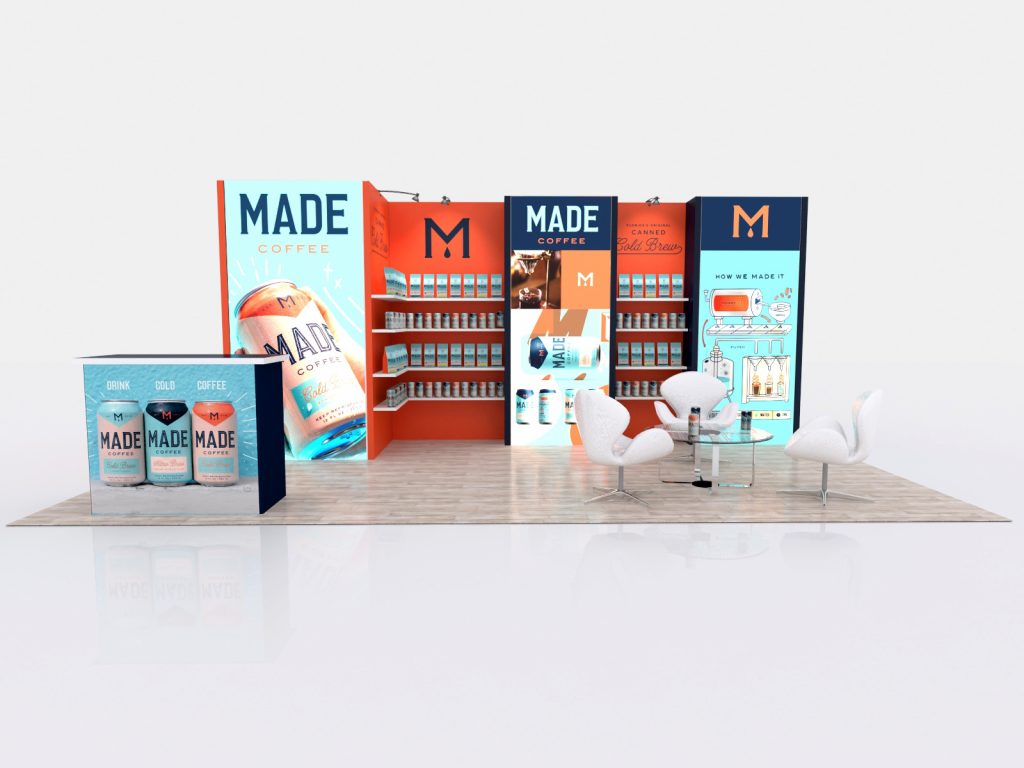
Save Big With Pre-Show Planning
17. Early Bird Forms
This is the easiest way to lower your trade show costs. There is a reason these early bird forms exist. The General Show Contractor wants you to complete them early, because the more information they have, the better they can prepare for the show.
Many exhibitors, however, procrastinate this task. While filling out these forms can be a painful exercise, it’s critical to submit them by the early bird deadlines. If you don’t have all the information you need, or some information will be subject to change, that’s okay. You can make corrections later. By sending in these forms early, you can save hundreds or even thousands of dollars.
18. Pre-assemble and Inspect Your Exhibit
While you may not like the idea of having to assemble the booth twice—once in your own shop or at your exhibit house, and then again on the trade show floor—this planning step is an important strategy for controlling trade show costs. Knowing what to expect in terms of assembly helps you save time and avoid any nasty surprises.
As any trade show veteran knows, when there’s an issue on the show floor, it’s almost always a painful and expensive fix. There are no cheap solutions on the trade show floor. Whether it’s overnighting graphics or getting a spare part over the weekend, everything is going to be more costly –– and stressful. Make sure everything is right before you ship your booth to the show. Having your booth only partially assembled on the day the show opens is worse than having your exhibit not arrive at all.
19. Prep Graphics, Literature, & Promotional Products
The exhibit is the main attraction. Always will be. But there are other marketing and operational tasks to complete, such as literature, promotional products, and shipping. All of these, when done ahead of time, will save you a significant amount of money and lessen your anxiety.
We tend to work toward a deadline. What if we worked well in advance of a deadline? For example, your supplier may give you a timeline of 7-10 days, like ordering a promotional giveaway. But a timeline of 7-10 days assumes everything goes according to plan. It won’t. Don’t wait until the last minute. Plan for ground shipping vs. overnight and assume there’ll be a glitch or two along the way. You’ll have the opportunity to see any mistakes and have them corrected early. As a bonus, you’ll sleep better the week before the show.
20. Cleaning Supplies
Cleaning fees, like vacuuming your booth space each morning, while convenient are expensive. It can cost hundreds of dollars simply to have someone vacuum your exhibit every morning. On the other hand, you can buy a $99 vacuum that can fit in your crate and ship with your booth, along with other necessary cleaning supplies. Make it a game with your exhibit staff. If everyone pitches in with the cleaning each day, the money you saved by not paying for cleaning services can go toward a post-show celebration.
21. Purchase Your Monitor at the Show City
This is a great cost-saving idea. You may need a monitor in your booth, and with the prices of flat screen TVs plummeting, you can get a nice one from $300 to $600 dollars depending on the size.
Instead of paying to ship that monitor to the show, simply buy it at the show city –– whether you’re in Las Vegas, Chicago, or Orlando. Then, to save the money on shipping the monitor back to your location, use it as a giveaway to encourage more booth traffic and collect more leads. Who doesn’t want to win a flatscreen TV?
22. Internet
Think hard about whether you really need to be connected to the Internet in your booth. Does it advance your trade show marketing program in any way? Or is it a distraction? Cell service may be all you need to connect your devices to the Internet.
Internet charges on the show floor can be extremely high, and connectivity is often unreliable, making it a wasted investment anyway. If you’re using lead retrieval or mobile order writing software, consider solutions that have offline access.
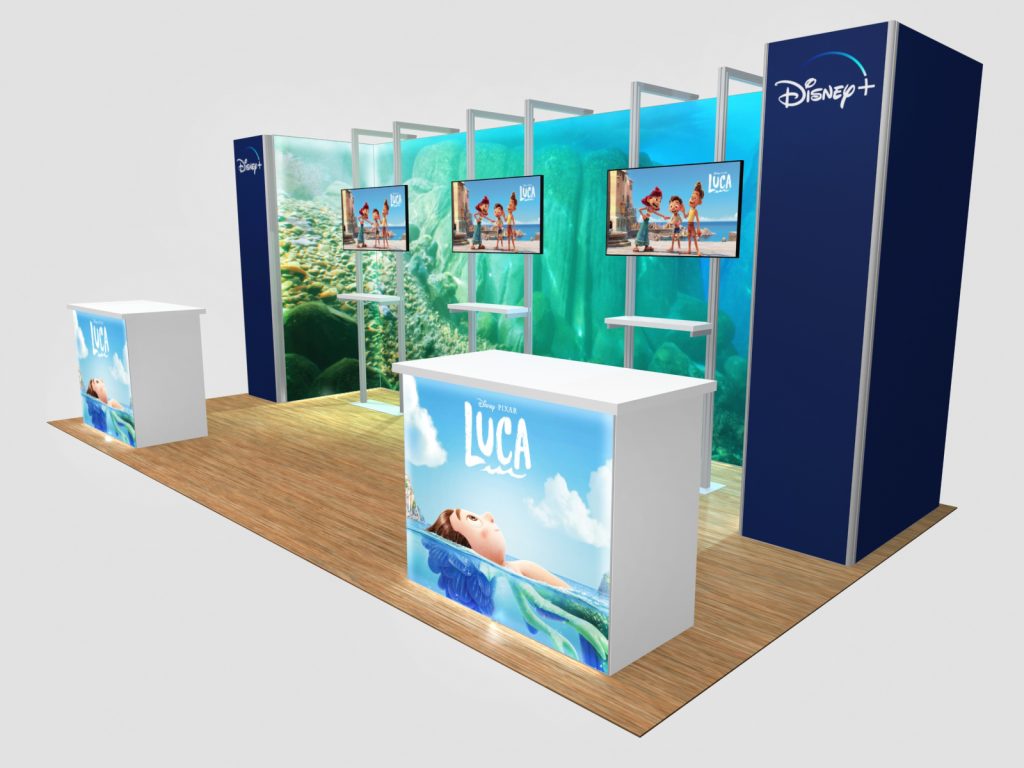
Smarter Lead Capture & Marketing on a Budget
23. Invest in Lead Retrieval Software
Whether you rent, purchase, or lease lead retrieval software depends on your show schedule and the sophistication of your lead management. Some exhibitors are only interested in collecting the most basic information: client name, contact information, show, and date. Others have a comprehensive list of questions they want answered and need the ability to email literature or follow up directly from the show. Others have specific requirements for their CRM software and how it should be uploaded and managed.
If you want to collect detailed information on your leads, lead retrieval software is a good way to save time, money, and headaches when it comes to lead retrieval at the show. However, choose the lead retrieval package that makes the most sense for your situation. Don’t pay for more than you need. And don’t buy less than you need, whether it’s for one show or for your entire show schedule. Cheaper software can actually be more expensive in the long run.
24. Share Advertising
This may not apply to everyone, but it can be a huge cost savings. If you have strategic industry partners who are exhibiting at the same show and have similar customers but aren’t direct competitors, explore opportunities to cooperate with them on show advertising and co-hosted events.
Splitting these costs will allow you to expand your marketing and networking while saving money. Splitting bar tabs and meals with common customers goes a long way without having any impact on your sales process.
25. Use Giveaways Strategically
Giveaways or promotional products are a staple of trade shows. However, not every exhibitor uses them strategically (or wisely). Don’t treat them like candy tossed from a float at a 4th of July parade. Instead, consider how a cheap pen giveaway will be perceived by trade show attendees. Giveaways should be part of an overall strategic trade show marketing plan.
When used wisely, trade show giveaways are an investment in your business. They serve as silent salespeople, promoting your company long after the trade show or sales event is over. If you are considering adding incentives to your marketing strategy, you are in luck. The incentives industry is a multi-billion-dollar business with a vast range of products that can be printed, embossed, programmed, or custom-made to enhance and bring attention to your trade show exhibit.
Trade show attendees are more likely to keep giveaways that are practical, useful, and memorable. Items like water bottles, tote bags, pens, and notebooks are popular choices because they have everyday applications. In addition, consider high-quality items which are more likely to be kept.
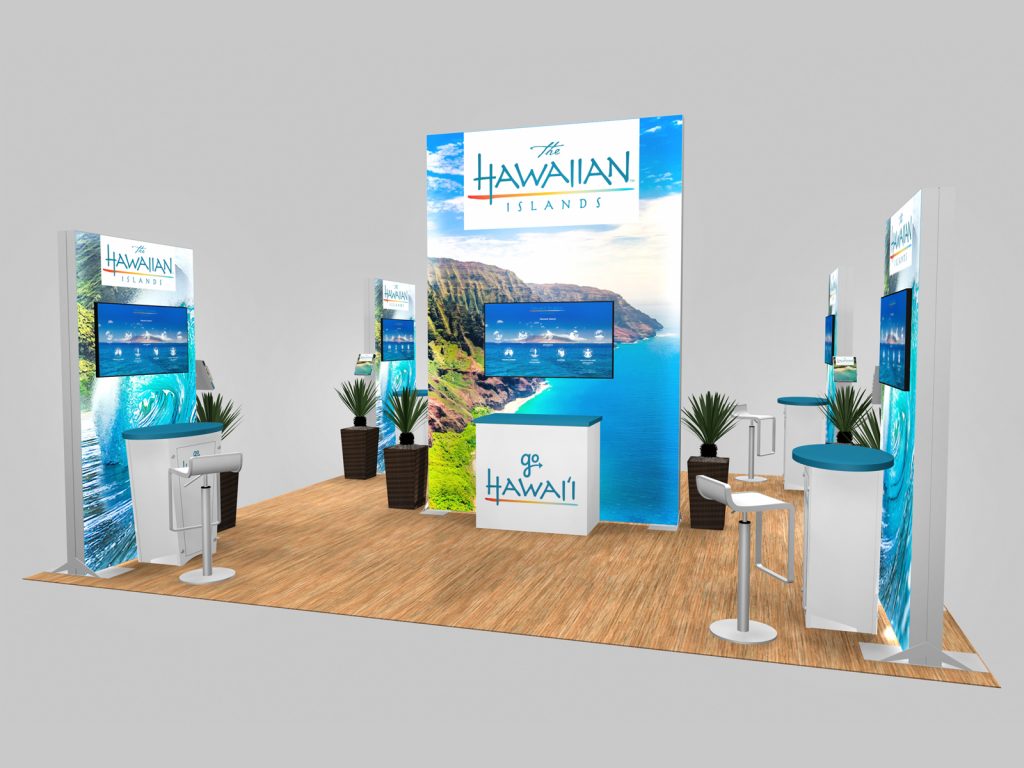
Budget-Friendly Travel & Lodging Tips for Exhibitor Teams
26. Rent a House
If you’re bringing a group of six or more people to a show, renting a house near the convention center can be a much more economical accommodation option than paying for individual hotel rooms. It also offers much more flexibility with transportation, meals, and meetings with clients.
27. Combine with a Company Retreat or Offsite
Many exhibitors use the house they rented as a venue for networking events and parties during the show. It’s also a great excuse for combining a company retreat or training with the trade show.
28. Share Team Meals
The meal budget at a trade show is often overlooked during planning… and then the individual expense reports hit the CFO’s desk and everyone starts pointing fingers. It’s not about eating fast food. It’s about making smart decisions. Consider staying at a hotel with a complimentary breakfast. If you’re renting a house (see #26), stock the pantry with grab-and-go groceries or plan a group dinner where everyone makes their favorite dish.
Even little decisions can make a huge difference. For example, if the show is in Las Vegas, it’s often significantly less expensive to take a taxi (or Uber) to an off-the-strip restaurant than eating in the casino. Consider shipping a couple of cases of water with your booth. That way it’s convenient during I&D and show hours and no one will be grumbling about having to pay $8 for bottled water at the concession stand.
Finally, wining and dining clients can be pricey, but many non-competing exhibitors have shared clients attending the trade show. Consider tag-team dining with clients and split the check. It’s a win-win for everyone.
Store Smarter: Reduce Repeated Shipping Fees
29. Store the Booth Locally
This applies to people with active trade show schedules in the same city. Rather than having the booth shipped back to the main office every time, look at having the booth stored locally in that city. It can be stored at a local or regional exhibit house, or with a transportation carrier that can store the booth for a nominal fee.
In fact, the storage fees may be less than what you would have paid to ship the booth to and from the show each time. Check with your Exhibit Appointed Contractor. They often have suggestions on storage options in convention-centric cities like Orlando, Las Vegas, and Chicago.
Cut Trade Show Rental Costs Without Cutting Quality
Here’s a secret. Walk any major trade show in Las Vegas, Orlando, or Chicago and you’ll notice one obvious change and one not so obvious one. Exhibits have gotten bigger, brighter, and bolder whether it’s a 10 ft. inline or a 30 x 40 island. It’s an impressive transformation. However, what you may not realize is that 25-35% of those designs are rentals. Yes, rental exhibits.
Rentals are no longer the ugly stepchildren. They’re indistinguishable from their purchase siblings. Exhibitors are choosing rentals for a multitude of reasons like cost, design flexibility, and no long-term ownership hassles. Here are eight reasons to rent your next trade show exhibit.
8 Reasons to Rent Your Next Exhibit:
1. Financial Flexibility: Renting generally requires a lower upfront investment compared to purchasing a booth. This frees up capital that can be allocated to other crucial marketing initiatives, staff training, or product development. It also eliminates ongoing expenses like storage, maintenance, and depreciation.
2. Design Flexibility: Trade shows vary in size, audience, and industry focus. Renting allows you to customize your booth’s design, size, and layout to perfectly match the specific requirements of each event. You can experiment with different configurations, graphics, and messaging, ensuring your presentation remains fresh and engaging for diverse demographics and varying floor plans.
3. Upscale Designs: The exhibition landscape is constantly evolving with new design trends and interactive technologies. Rental providers frequently update their inventory, giving you access to the latest innovations without the commitment of ownership. This enables your brand to showcase a modern and cutting-edge image at every event.
4. Minimal Ownership Headaches: Owning a booth comes with responsibilities like storage, transportation, setup, and dismantling, which can be complex and costly. Rental agreements typically include comprehensive support services, alleviating these challenges. This means less stress and more time for your team to focus on engaging with prospects and maximizing the trade show’s potential.
5. Just “Testing the Waters”: If you’re new to trade shows or want to test a new market or product, renting is a low-risk way to get started. It allows you to gauge the effectiveness of trade show marketing for your business before making a significant investment in a custom-built booth.
6. Flexible Rebranding: Trends change, and companies rebrand. An owned booth can become outdated or no longer align with your brand identity, requiring costly modifications or replacement. Renting allows you to easily update your look or completely change your exhibit to reflect new branding or marketing strategies.
7. Sustainable: Renting aligns with eco-friendly practices by promoting the reuse of exhibition booth components. This reduces waste and the demand for new materials, contributing to a more sustainable exhibiting approach.
8. Faster Solutions and Less Planning: If you decide to attend a trade show at the last minute or have a tight deadline, renting can be a faster and more efficient solution than designing and building a custom exhibit from scratch. Rental companies often have pre-configured options that can be quickly customized with your branding.

Final Thoughts on Trade Show Costs: Plan Strategically, Spend Intentionally
Trade show costs continue to rise, just like all marketing costs. That shouldn’t surprise anyone. However, savvy marketers do what they’ve always done with their trade show program: they plan strategically, and spend intentionally. They can’t (and shouldn’t) rely on the show organizers to drive prospects to their booth. Nor should they assume that handshakes, mints, and a new booth will close sales.
ROI matters to the C-Suite, which means managing costs while creating anxious curiosity before the show, meaningful experiences during the show, and eager follow-up after everyone has headed home. The key to managing trade show costs isn’t to be cheap. It’s making wise choices that ensure the strategic marketing plan meets its goals.
For over 30 years, Classic Exhibits has been designing and building creative custom solutions for our Distributor Partners and their clients. As North America’s largest private-label exhibit manufacturer, we have the unmatched capability, capacity, and creativity to create 3D projects ranging from 10 x 10 inline displays to 60 x 80 double-deck islands.
Find success on the trade show floor with an exhibit that reflects your marketing message. For more information, see www.classicexhibits.com and explore Exhibit Design Search or request a meeting with a Classic Distributor Partner.
Tags: Classic Exhibits, Exhibitions, trade show costs, Trade Shows



